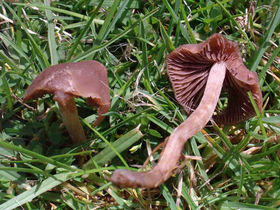Lawn Mushrooms
Autumn is when many fungi produce their fruiting bodies; mushrooms or toadstools. For much of the year fungi are present as unseen mycelia in the soil, growing on dead trees roots and other organic matter in the soil. Lower soil temperatures and increased soil moisture in autumn cause the strands of the mycelia to amalgamate, forming fruiting bodies. A few fungi associated with lawns, such as Marasmius oreades (fairy rings) can damage turf, but the small brown mushrooms that appear are harmless. Do not eat wild mushrooms unless you are certain it is safe to do so.
Why do they grow in my lawn?
When turf is being harvested damage is caused to the roots and other underground parts of the turf. Microscopic bacteria decompose the dead and dying tissue once the turf has been laid. They emerge in a flush of growth and may persist for a few weeks at most, then disappear. Occasionally a second brief outbreak may occur, possibly during the next period of warm moist weather.
Is my lawn diseased?
In some gardening books, the only reference to toadstools in turf is in connection with fairy rings, which can be a very serious problem on mature lawns. The small brown mushrooms found in newly laid turf are completely different from those found in fairy rings, and have no long term consequences. If mushrooms of colours other than brown are found, it is likely that they are living on buried wood, for example tree roots. In this case, the mushrooms will be found immediately above the decaying wood. Removing the wood will prevent fungi of this type from growing.
Are they poisonous?
Without accurate identification it is impossible to say whether mushrooms are poisonous. As a precaution it would be wise to keep small children away from them, since they may be harmful if eaten in quantity; as is the case with many things found in the garden.
Can they be treated?
There are no fungicides recommended in the UK for use against these mushrooms. However, since they are not damaging to the turf, and are part of a natural and temporary process, there is no need to treat them. The best approach is to remove the mushrooms from the lawn by mowing the affected area on a daily basis until no more are produced. Alternatively breaking their stems by brushing the mushrooms will allow them to dry out and disappear as they are composed mainly of water.

 Delivery
Delivery Basket
Basket Checkout
Checkout How will my items be
delivered?
How will my items be
delivered?
 How to keep my lawn
healthy?
How to keep my lawn
healthy?









